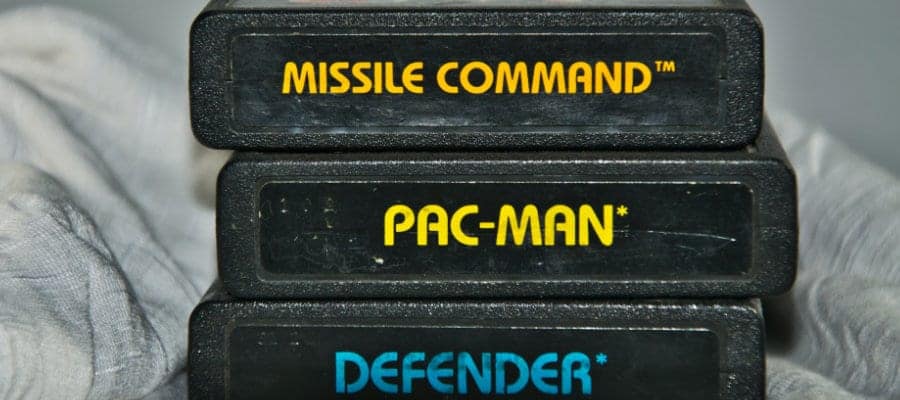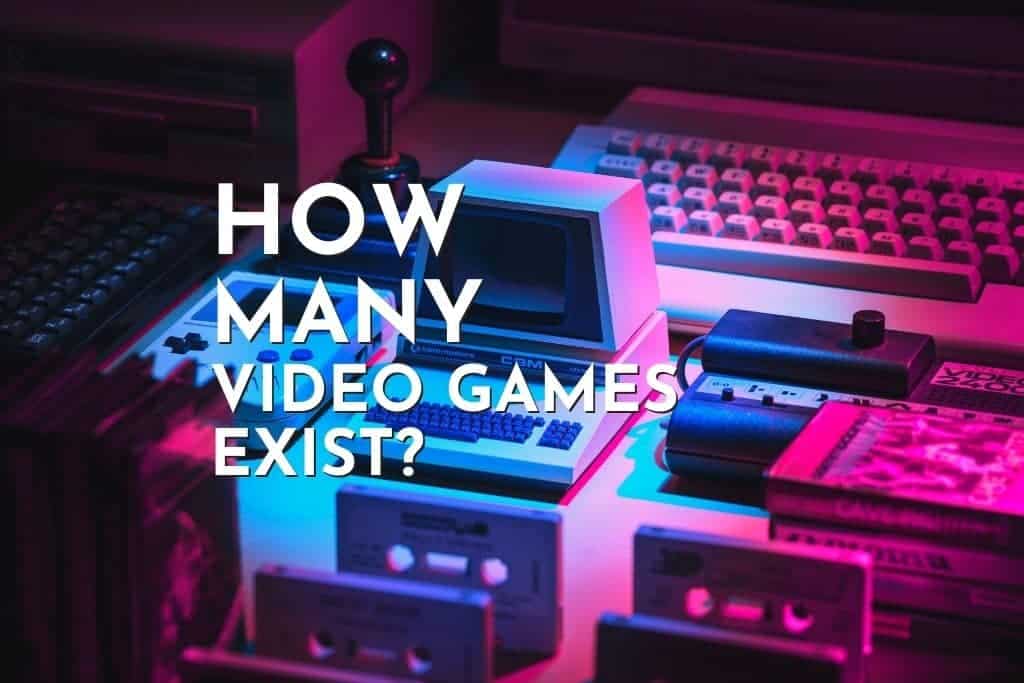As a gaming enthusiast, you’re exposed to a wide variety of games spanning across multiple genres or even platforms (PC. Mobile, Console). And whenever you see something interesting, it occupies a spot on your future “to-play” list.
Yeah, you’ll play it right after you’ve gone through your backlog of 20 Steam games that were purchased during last year’s Summer Sale. But wait a minute, what if you had no work to do and just played games all day?
While that concept sounds fantastic, we bet you still cannot finish every game out there in your entire lifetime. Don’t believe us? Read the rest of the article to find out more.
Now you might be thinking, how many video games exist? After doing some research, our total comes out to 1181019. This includes 33554 games on Steam, 199 games on Uplay, 3125 games on GoG, 327491 games on Google Play, 811911 games on the App Store, 1893 games for the PS4, 1760 games for the Xbox One, and 2330 games for the Nintendo Switch.
How I Found How Many Video Games There Is

While you could go on Wikipedia and painstakingly count every single game released for the PC ever, a much easier way to do it is by looking at Steam and other online distribution platforms such as GoG, Uplay, Origin, etc.
For mobile, we can check out Statista, which gives us data on the number of available gaming apps in both the Apple App Store and Google Play store.
For console, we will consider the Switch, PS4, and Xbox One since these are the current-gen platforms owned by most people. But is this really the total number of video games in existence?
Well, the answer isn’t quite straightforward. We need to consider exactly what we’re trying to count as a “video game” here. Is it Triple-A releases from big publishers like EA, Ubisoft, and Activision? Do we also consider Indie games and casual/ hyper-casual games on mobile? What about some homebrew game code is written up by Eugene in his bedroom when he was 15?
Many popular games often get massive expansions, DLCs, and remasters. Do those count as separate games from the base version? For example, The Witcher 3: Wild Hunt is an amazing RPG filled with interesting characters and a compelling storyline.
But CD Projekt Red released two amazing expansions titled “Hearts of Stone” and “Blood and Wine,” which can be considered complete games by themselves because they add new stories and areas to the base game with several hours of additional playtime and content.
And what about remasters, like how Activision released a version of the original Modern Warfare with updated graphics in 2016. Does that count as a game by itself?
The simple way to do it would be to calculate the total number of games on each platform and add it all up. But then you’ve got to consider the fact that the PC market isn’t exactly covered with Steam sales alone, even though that is the biggest online game distribution platform.
For the sake of simplicity, we must leave out games created for older platforms like the Apple II, Commodore 64, Sinclair Spectrum, and other extremely old personal computer platforms.
The same has to be done for the console side of things; we cannot account for the games released on retro consoles such as the SNES, Nintendo 64, etc. This is done for two reasons- firstly, it would be impossible to account for all the homebrew titles that random people came up with for these older personal computers.
Many of these machines from the ’80s were user-programmable, so we’re talking about potentially tens of thousands of indie games that were never commercially released.
Secondly, you’ve got to consider the fact that a lot of these games were copies of the big commercial successes from that time, such as Space Invaders, Mario, or Pong. For retro consoles, it is hard to get an exact number because when you go on ROM sites, they list literally every hack ever created for the original titles, along with regional releases as separate games.
For example, the US and European versions of certain console games back in the day were optimized differently- identical games but tuned for 50Hz TVs instead of 60Hz.
Finally, we aren’t going to count Flash games and HTML5 based mini-games for browsers. Because that will literally take the total into the millions. Just one website like this has hundreds of Flash games on it, and there are thousands of such websites out there. You might as well go to a beach and start counting the number of sand particles.
The Evolution of Gaming

Today the games industry is a multibillion-dollar juggernaut that has consistently outperformed movies and music combined for the past decade. We have more games than there are people in the city of Washington, DC. And the number keeps growing daily, with record revenues being posted each consecutive.
There is no doubt that gaming as a form of entertainment is in its own league, and it delivers a form of storytelling that is completely different from watching a movie. In a game, you are the hero. You feel much more involved, and every year we keep getting closer to photorealistic visuals.
But things were extremely different just 20 or 25 years ago. Gaming was considered a niche, and gamers were stereotyped as basement dwellers with too much free time. So how did we get here?
The Great Grandaddy Of Video Games – Nimatron

It all started back in the 1940s and 50s when the personal computer was but a figment of imagination in the minds of some extremely intelligent people. Back then, nobody had even thought of using computers to deliver entertainment.
The earliest example of a game machine was created by Dr. Edward Uhler Condon and put on display at the New York World Fair in 1940. This ancient game machine could play only one game, and it was electromechanical in design.
It was called the Nimatron and played the mathematical game of strategy known as “Nim.” People played 100,000 games of Nim at the fair, and the Nimatron won 90,000 of them.
When Did The First Game Console Come Out?

The first video game machine designed for home use would take a while to come, nearly 3 decades after the Nimatron- in 1967 when Ralph Baer released his “Brown Box” prototype.
This would be the foundation for many game consoles to be released in the future. The Brown Box would connect to your TV, and it could play ping pong, checkers, and a couple of sports games. There was even a light gun for basic target shooting games.
Technology like this is commonplace today but was unheard of back in the 60s. There was even an attachment for playing golf. This prototype was well received internally, and the design was licensed to Magnavox, who released it commercially as the Magnavox Odyssey in 1972. Atari came a few months later, so Magnavox technically made the first video game console ever with the Odyssey.
While Magnavox and Ralph Baer invented the concept, Atari popularized it and transformed video game consoles into a product that the average consumer wanted. They released the first electronic video game- Pong, and we are sure you have played this game in some form or the other in your lifetime.
There are several copies of Pong available today from various Indie developers, each adding their own twist to the classic game. Thanks to Pong, the 70s and 80s became an arcade fest.
You had Pong machines in restaurant chains, bowling alleys, shopping malls, and resorts. Eventually, this led to people competing among themselves to see who can score higher in Pong, and it was the beginning of competitive or multiplayer gaming.
With the advent of microprocessors thanks to Intel, personal computers became a common purchase in nearly every household towards the 90s. Game consoles like the PlayStation emerged, and with the onset of the World Wide Web, we were able to communicate and play with strangers from several thousand miles across the world.
Around 2007- 09, services such as Xbox Live introduced console gamers to a brand new world of opportunities. Now you could own newbies in Halo or COD while listening to a 12-year-old boy screaming expletives into your ears.
Things took another drastic shift in 2007 after Steve Jobs introduced the iPhone and this little thing we call an “app.” Nowadays, nearly half of all apps downloaded are games.
Mobile gaming added a new dimension of possibilities in the realm of game development. People could take their games anywhere, play on the toilet seat, in the car, or while flying 30,000 feet above the ground on their trip across the world.
And thus began the trend of freemium games. These are technically “free to play” but will cost you money if you want to make any progress within a reasonable amount of time.
Soon we got casual and hyper-casual games on the phone, geared towards rewarding the player with instant incentives to lure them back for another round. Microtransaction and in-game ads became commonplace, and within a span of just 5 to 7 years, the mobile gaming market has gone from insignificant to claiming half of all gaming revenue in the world.
How Many Mobile Games Are There?

According to a study by lifewire.com, there are a total of 2.2 million apps on the Apple App Store for iOS devices. Out of these, nearly 37 to 40 percent are games. Based on data shown by Statista from 2018, the App Store had 811,911 active games on it in July. That number has likely grown closer to 900,000 by now.
At one point, nearly 500 games were being released per day on average for the App Store, according to this Gamasutra article from 2016. To put things in perspective, if you took 1 minute to review a single game, it would take you over 8hrs daily just to review the new releases for that day.
Normally, the majority of these games never make it onto the front page and are forgotten over time. Occasionally you get a smash hit out of nowhere like Angry Birds or Candy Crush. Based on the latest data from pocketgamer.biz, the App Store is now home to 3.948 million apps. Out of these apps, over 900 thousand are games.
The average price of a game on the App Store is 0.5 dollars, so it would cost you around 450K dollars to buy the entire catalog of games. With that sort of money, you could buy yourself a 2- bedroom condo in LA. Or, a Lamborghini Aventador.
Things are looking pretty good on the Google Play Store if we examine this chart from Statista, which shows the available gaming apps for the 1st through the 4th quarter of each year between 2015 and 2019. According to it, you have access to over 327,000 games on the Play Store right now in Q1 of 2019.
How Many Console Games Are There?

For PC, we can check out databases for names of all releases since the 50s on sites like mobygames.com or uvlist.net. Or, you can look up Steam and check the total number of games on that platform.
How do you do it for consoles? Because since the 70s, there have been all sorts of console models, each with its own unique set of games designed for that specific hardware platform.
It is possible to check the total number of games for current-gen models like the PS4, Xbox One, Nintendo Switch, etc., by visiting their official game store and selecting all games to get a total count.
But what about older generations like the PS3, PS Vita, Xbox 360, or even retro consoles like the Sega Genesis or NES? This article from bitrebel.com shows an infographic that helps get a perspective on just how many official game releases there have been for all major game consoles until now.
We can see that retro consoles such as the Nintendo 64, GameCube, NES, Wii U, and SNES each sold several million units. The driving force behind these sales were signature games such as Mario for the Nintendo consoles, Sonic for the SEGA consoles, etc. Gran Turismo was a huge hit on the original PlayStation, and the PS2 was helped heavily by “God of War” and “Uncharted” sales.
Apparently, there are a total of 2412 games for the PS2, 1432 games for the PS3, and 1316 games for the PS4. The game count for the PS4 has grown a lot since then, as the official store states there are 1893 games now (excluding bundles). The game numbers for older consoles should still be reliable since no new games are being released for the PS2 or PS3.
Conclusion
With the PlayStation 5 and Xbox Scarlett release next year, we will be flooded with even more game releases. Mobile gaming looks stronger than ever, and Chinese studios are pumping out hundreds of new ideas daily.
As games these days are rarely restricted by hardware, developers can truly let their imagination flow free and reward us with new forms of storytelling and truly unique experiences.
With backward compatibility being confirmed for next-gen consoles, you can pop in disks from your old game collection and play them whenever you are feeling nostalgic.
And that is taken one step further on PC, where you can literally download any of the several hundred DOS games from the 80s and play it right now. Or, you can emulate PS2 and Nintendo games such as God of War or Zelda.
An online Pastebin user is known as “Data_Baser” has undertaken the Goliathan task of cataloging every single video game made, ever. With the help of the 4chan retro games board, this person is recording games as old as Computer Space and Galaxy Game from 1971!
This list even includes multi-platform releases for every single game and is currently sitting at 49,668 entries. It doesn’t include a bunch of the smaller mobile games that are released daily but played by a few.
And they haven’t included all the Flash and HTML-based browser games because that would honestly be impossible to do. This Pastebin sheet was compiled with the help of mobygames.com and uvlist.net and was last updated in April of 2015. There have been several game releases since then that weren’t documented in the database.


How many video games are there?
We depend on how you count. But I would personally only count games that were released on physical media. Since games that are DLC, Smart/phones, Browser/Flash are not sold in-store where you can look at the box art and hold it in your hand, same would probably go for those early devices like Nintendo Satelleview since there were no physical copes ever released on those games. Yet they were broadcasted through the air and those Satelleviw games have probably more in common with the through the air broadcast of ABC, NBC, CBS than with thair modern digital download counterparts.
Then I probably would only count official releases on those consoles and platforms.
Thanks for the input.
I tried to count as many platforms as possible, as we are speaking about video games in general.
As we progress we see less physical media being release, so not to count them will be a miss-representation.
Hi Jacob Sobolev
this is Raul i wanted to know when this was published. I am currently taking classes and need to cite my information but i’m having trouble finding the date. Thank you
Hi Raul,
This information is up to date.
I always update my articles whenever they need to, so you will receive the best information you can.